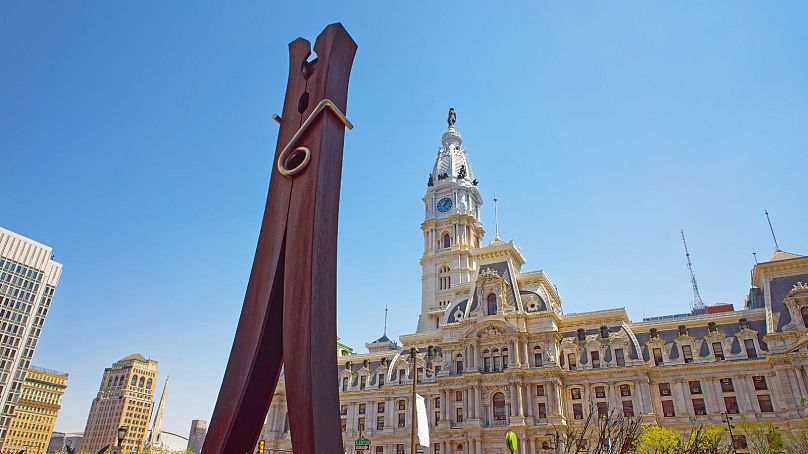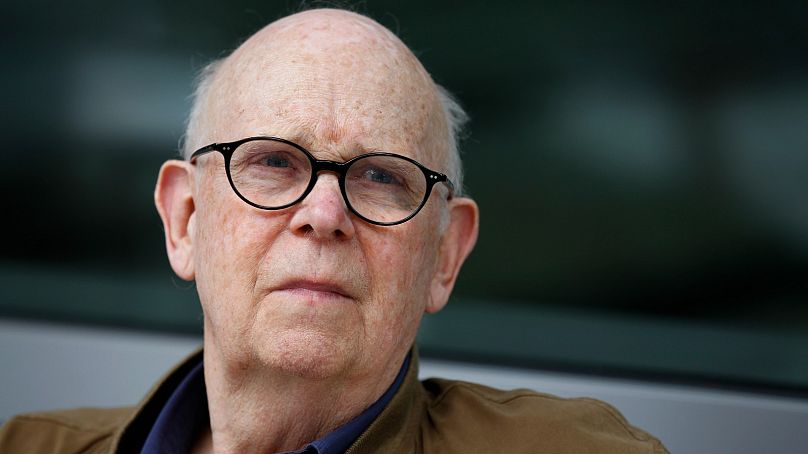Pop artist Claes Oldenburg turned the mundane into the monumental through his outsized sculptures of a baseball bat, a clothespin and other objects.
Pop artist Claes Oldenburg, who turned the mundane into the monumental through his outsized sculptures of a baseball bat, a clothespin and other objects, has died aged 93.
Oldenburg died on Monday morning in Manhattan, according to his daughter, Maartje Oldenburg. He had been in poor health since falling and breaking his hip a month ago.
The Swedish-born Oldenburg drew on the sculptor’s eternal interest in form, the dadaist’s breakthrough notion of bringing ready-made objects into the realm of art, and the pop artist’s ironic, outlaw fascination with lowbrow culture - by reimagining ordinary items in fantastic contexts.
“I want your senses to become very keen to their surroundings,” he told the Los Angeles Times in 1963.
“When I am served a plate of food, I see shapes and forms, and I sometimes don’t know whether to eat the food or look at it,” he said. In May 2009, a 1976 Oldenburg sculpture, “Typewriter Eraser", sold for a record $2.2 million (€2.1M) at an auction of post-war and contemporary art in New York.
Early in his career, he was a key developer of “soft sculpture” made out of vinyl - another way of transforming ordinary objects - and also helped invent the quintessential 1960s art event, the “Happening".
Among his most famous large sculptures are “Clothespin", a 14-metre high steel clothespin installed near Philadelphia’s City Hall in 1976, and “Batcolumn", a 100-foot lattice-work steel baseball bat installed the following year in front of a federal office building in Chicago.
“It’s always a matter of interpretation, but I tend to look at all my works as being completely pure,” Oldenburg told the Chicago Tribune in 1977, shortly before “Batcolumn” was dedicated. “That’s the adventure of it: to take an object that’s highly impure and see it as pure. That’s the fun.”
The placement of those sculptures showed how his monument-sized items - though still provoking much controversy - took their place in front of public and corporate buildings as the establishment ironically championed the once-outsider art.
Many of Oldenburg’s later works were produced in collaboration with his second wife, Coosje van Bruggen, a Dutch-born art historian, artist and critic whom he married in 1977. The previous year, she had helped him install his 12.5 metre “Trowel I” on the grounds of the Kroller-Muller Museum in Otterlo, the Netherlands.
Van Bruggen died in January 2009.
Oldenburg’s first wife, Pat, also an artist, helped him out during their marriage in the 1960s, doing the sewing on his soft sculptures.
The Happening
Oldenburg’s first blaze of publicity came in the early '60s, when a type of performance art called the Happening began to crop up in the artier precincts of Manhattan.
A 1962 New York Times article described it as “a far-out entertainment more sophisticated than the twist, more psychological than a séance and twice as exasperating as a game of charades".
One Oldenburg concoction, cited in the 1965 book “Happenings” by Michael Kirby, juxtaposed a man in flippers soundlessly reciting Shakespeare, a trombonist playing “My Country ’Tis of Thee", a young woman laden with tools climbing a ladder, a man shovelling sand from a cot and other oddities, all in one six-minute segment.
“There is no story and the events are seemingly meaningless,” Oldenburg told the Times. “But there is a disorganised pattern that acquires definition during a performance.” He said the sessions - unscripted but loosely planned in advance - should be a “cathartic experience for us as well as the audience".
Oldenburg’s sculpture was also becoming known during this period, particularly ones in which objects such as a telephone or electric mixer were rendered in soft, pliable vinyl. “The telephone is a very sexy shape,” Oldenburg told the Los Angeles Times.
One of his early large-scale works was “Lipstick (Ascending) on Caterpillar Tracks", which juxtaposed a large lipstick on tracks resembling those that propel Army tanks. The original - with its undertone suggestion to “make love (lipstick) not war (tanks)” - was commissioned by students and faculty and installed at Yale University in 1969.
The original version deteriorated and was replaced by a steel, aluminium and fibreglass version in another spot on the Yale campus in 1974.
Oldenburg’s “Clothespin” was installed in 1976 outside Philadelphia’s City Hall. It evokes Constantin Brancusi’s 1908 “The Kiss", a semi-abstract depiction of a nearly identical man and woman embracing eyeball to eyeball. “Clothespin” resembles the ordinary household object, but its two halves face each other in the same way as Brancusi’s lovers.
The Chicago “Batcolumn” was funded by the federal government as part of a programme to include a budget for artworks whenever a big federal building was put up. It took its place not far from Chicago’s famed Picasso sculpture, dedicated in 1967.
“Batcolumn", Oldenburg told the Tribune, “attempts to be as non-decorative as possible - straightforward, structural and direct. This, I think, is also a part of Chicago: a very factual and realistic object. The final thing, though, was to have it against the sky, that’s what it was made for.”
He had considered making it red, but “colour would have simply distracted from the linear effect. Now, the more buildings they tear down around here, the better it will get".
Chicagoans weren’t uniformly pleased. At around the same time as the sympathetic Tribune interview, another Tribune writer, architecture critic Paul Gapp, decried the trend toward “idiotic public sculpture” and called Oldenburg “a veteran put-on man and poseur who long ago convinced the Art Establishment that he was to be taken seriously".
Among Oldenburg’s other monumental projects: “Crusoe Umbrella", for the Civic Center in Des Moines, Iowa, completed in 1979; “Flashlight", 1981, University of Las Vegas; and “Tumbling Tacks", Oslo, 2009.
Oldenburg was born in 1929 in Stockholm, Sweden, son of a diplomat. But young Claes (pronounced klahs) spent much of his childhood in Chicago, where his father served as Swedish consul general for many years. Oldenburg eventually became a US citizen.
As a young man, he studied at Yale and the Art Institute of Chicago and worked for a time at Chicago’s City News Bureau. He settled in New York by the late 1950s, but at times has also lived in France and California.













